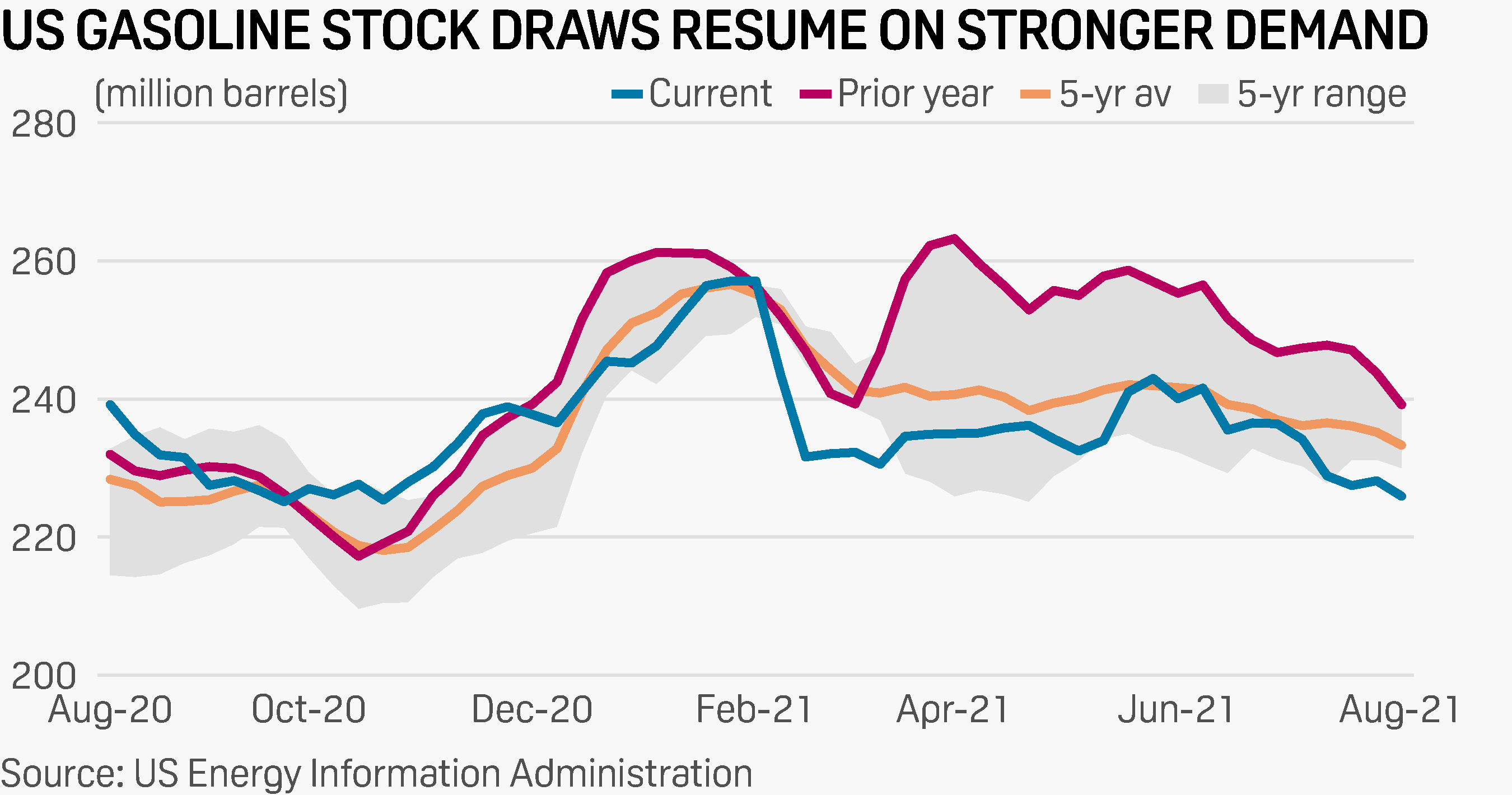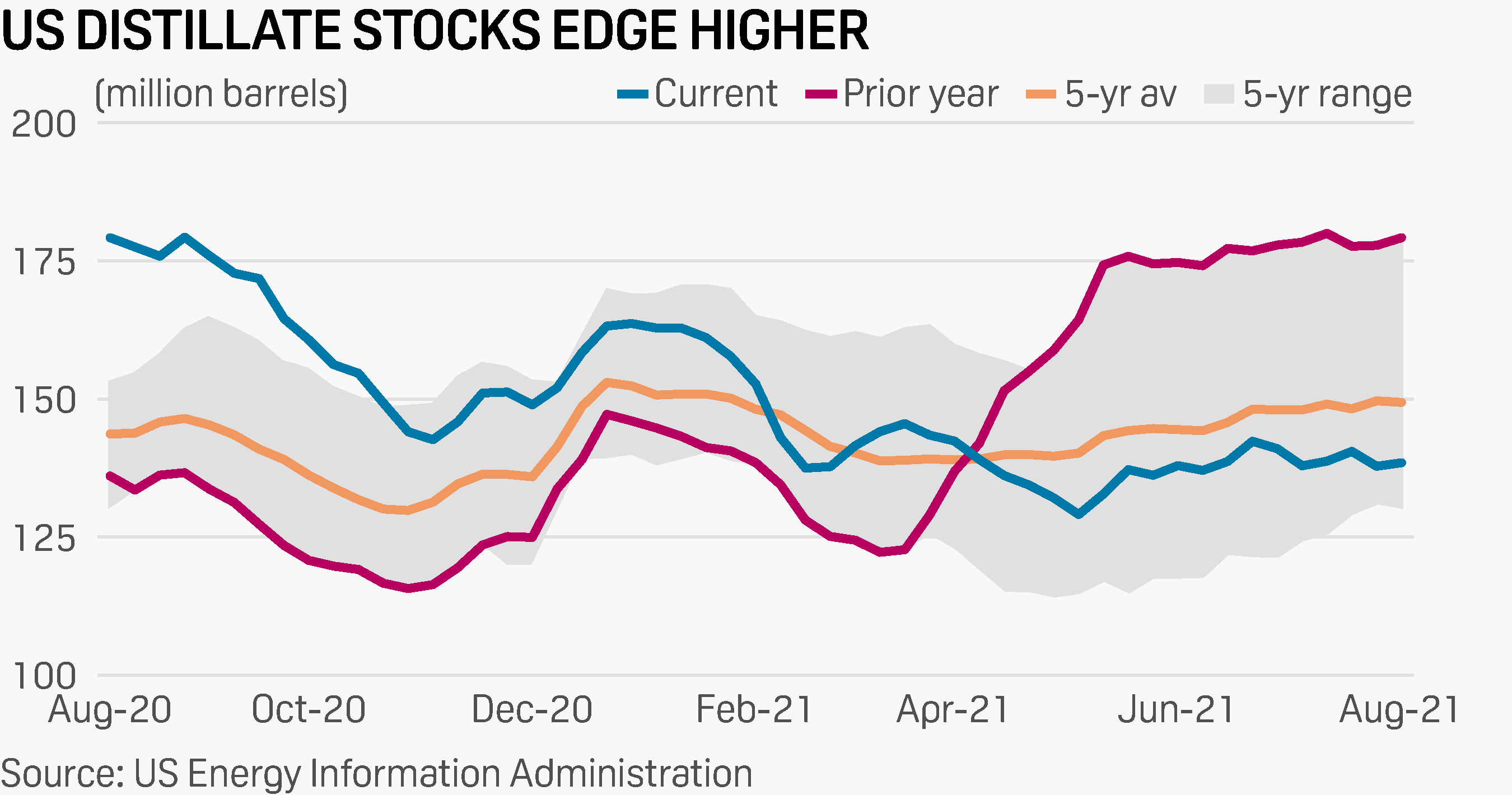

US gasoline inventory draws extended in the week ended Aug. 20, US Energy Information Administration data showed Aug. 25, amid stronger demand and a surge in exports.
Total US gasoline stocks declined 2.24 million barrels in the week ended Aug. 20, EIA said, leaving stocks 3.2% behind the five-year average and at the lowest since October 2020.
The draw was concentrated on the US Atlantic Coast where stocks fell 2.32 million barrels to 56.38 million barrels, the lowest since the week ended March 23, 2018. USAC gasoline stocks are now down over 14 million barrels since their most recent peak during the week ended June 25 and are nearly 13% behind the five-year average for this time of year.
NYEMX front-month September RBOB settled up 12 cents at $2.3008/gal Aug. 25.
The inventory draws come as weekly implied demand for gasoline climbed 2.6% to 9.57 million b/d, a three-week high.
Weekly exports of gasoline averaged 910,000 b/d, a 40% increase from the week prior and an 11-week high. But despite the sharp uptick in weekly exports, the four-week moving average climbed to just 730,000 b/d from 690,000 b/d the week prior, putting it back within the range seen since early July.
So far, these tightened availabilities have yet to draw significantly more imports. The four-week moving average of inbound gasoline volumes climbed to around 900,000 b/d last week from 860,000 b/d the week prior, down around 17% from 1.09 million b/d seen during the week ended June 23.

The arbitrage incentive for moving gasoline from Northwest Europe into New York Harbor has averaged $4.21/b to date in August, S&P Global Platts Analytics data shows, up from $2.14/b seen during July.
But gasoline inventories in the Amsterdam-Rotterdam-Antwerp trading hub are at at their lowest point since Oct. 27, 2016, limiting the amount barrels that could take advantage of these strong incentives. The tight availabilities is largely a reflection of strong prompt demand in Europe, particularly in the Mediterranean where peak holiday demand for the road fuel was expected to last for another three-four weeks. This has drawn gasoline from Northwest Europe into the Mediterranean, thinning tonnage lists for transatlantic shipments.
Total US distillate stocks climbed 650,000 barrels to 138.46 million barrels. The NYMEX September ULSD contract climbed 5.14 cents to settle at $2.1182/gal.
CRUDE STOCKS NOTCH 19-MONTH LOW
Total US commercial crude stocks fell 2.98 million barrels to 432.56 million barrels, EIA said, marking a fresh 19-month low.
The draw was largely in line with market expectations. Analysts surveyed by S&P Global Platts Aug. 23 had called for a 3.2 million-barrel draw over the period.
NYMEX October WTI settled 82 cents higher at $68.36/b and October Brent finished up $1.20 at $72.25/b.
The crude draw was concentrated on the US Gulf Coast, where stocks fell 1.42 million barrels, and in the Rocky Mountains, which saw a 1.07 million-barrel inventory draw. It was the largest one-week draw in Rocky Mountain stocks since the week ended Sept. 4, 2020.

Notably, stocks at the NYMEX delivery point of Cushing, Oklahoma, climbed 70,000 barrels to 33.67 million barrels. The build marks the first time Cushing stocks have expanded since the week ended June 4. The 10-week slide has seen inventories at the storage hub drain 12 million barrels since early June, and even after last week’s build stocks remain around 30% behind the five-year average.
Crude stocks saw pressure from a counterseasonal uptick in refinery demand. Total net crude inputs edged 70,000 b/d higher to 16.07 million b/d while refinery utilization averaged 92.4% of capacity, an increase of 0.2 percentage point from the week prior.
Refinery utilization typically begins to decline in late August as summer driving season demand wanes and shoulder-season turnaround work ramps up.
A continued slide in imports further weighed on inventories. Weekly inbound volumes fell for a fifth straight week to 6.16 million b/d, down from 6.35 million b/d the week prior and the lowest since the week ended July 2.
Source: Platts